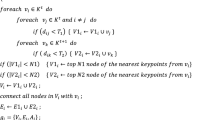Abstract
We describe a robust algorithm for object tracking in long image sequences which extends the dynamic Hough transform to detect arbitrary shapes undergoing arbitrary affine motion. The proposed tracking algorithm processes the whole image sequence globally. First, the object boundary is represented in lookup-table form, and we then perform an operation that estimates the energy of the motion trajectory in the parameter space. We assign an extra term in our cost function to incorporate smoothness of changes due to rotation or scaling of the object. There is no need for training or initialization, and an efficient implementation can be achieved with coarse-to-fine dynamic programming and pruning. The method is shown to be robust under noise and occlusion and capable of tracking multiple objects.








Similar content being viewed by others
References
Nash JM, Carter JN, Nixon MS (1997) Dynamic feature extraction via the velocity Hough transform. Pattern Recognit Lett 18(10):1035–1047
Lappas P, Carter JN, Damper RI (2002) Robust evidence-based object tracking. Pattern Recognit Lett 23(1–2):253–260
Grant MG, Nixon MS, Lewis PH (2002) Extracting moving shapes by evidence gathering. Pattern Recognit 35(5):1099–1114
Hough PVC (1962) Method and means for recognizing complex patterns. US Patent 3069654, December 18
Illingworth J, Kittler J (1988) A survey of the Hough transform. Computer Vis Graph Image Processing 44(1):87–116
Ballard DH (1981) Generalizing the Hough transform to detect arbitrary shapes. Pattern Recognit 13(2):111–122
Kassim AA, Tan T, Tan KH (1999) A comparative study of efficient generalised Hough transform techniques. Image Vis Comput 17(10):737–748
Canny J (1986) A computational approach to edge detection. IEEE Trans Pattern Anal Machine Intell 8(6):679–698
Rangarajan K, Shah M (1991) Establishing motion correspondence. Comput Vis Graph Image Processing Image Understanding 54(1):56–73
Bellman R (1957) Dynamic programming. Princeton University Press, Princeton
Kass M, Witkin A, Terzopoulos D (1987) Snakes: active contour models. Int J Comput Vis 1(4):321–331
Cohen LD (1991) On active contour models and balloons. Comput Vis Graph Image Processing 53(2):211–218
Gunn SR, Nixon MS (1997) Robust snake implementation; a dual active contour. IEEE Trans Pattern Anal Machine Intell 19(1):63–68
Sethi IK, Jain RC (1987) Finding trajectories of feature points in a monocular image sequence. IEEE Trans Pattern Anal Machine Intell 9(1):56–73
Raphael C (2001) Coarse-to-fine dynamic programming. IEEE Trans Pattern Anal Machine Intell 23(12):1379–1390
Blake A, Isard M (1998) Active contours: the application of techniques from graphics, control theory and statistics to visual tracking of shapes in motion. Springer, London
Benn DE, Nixon MS, Carter JN (1997) Robust eye centre extraction using the Hough transform. In: Proceedings of 1st international conference on audio- and video-based biometric person authentication, Crans-Montana, pp 3–9
Li M, Kambhamettu C (2002) Motion-based post processing of deformable contours. In: Third Indian conference on computer vision, graphics and image processing (ICVGIP 2002), Ahmedabad. No pagination, proceedings on CD-ROM
Peterfreund N (1999) The velocity snake: deformable contour for tracking in spatio-temporal space. Comput Vis Image Understanding 73(3):346–356
Peterfreund N (1999) Robust tracking of position and velocity with Kalman snakes. IEEE Trans Pattern Anal Machine Intell 21(6):564–569
Author information
Authors and Affiliations
Corresponding author
Rights and permissions
About this article
Cite this article
Lappas, P., Damper, R.I. & Carter, J.N. Object tracking by energy maximization. Soft Comput 10, 20–26 (2006). https://doi.org/10.1007/s00500-005-0459-y
Published:
Issue Date:
DOI: https://doi.org/10.1007/s00500-005-0459-y




